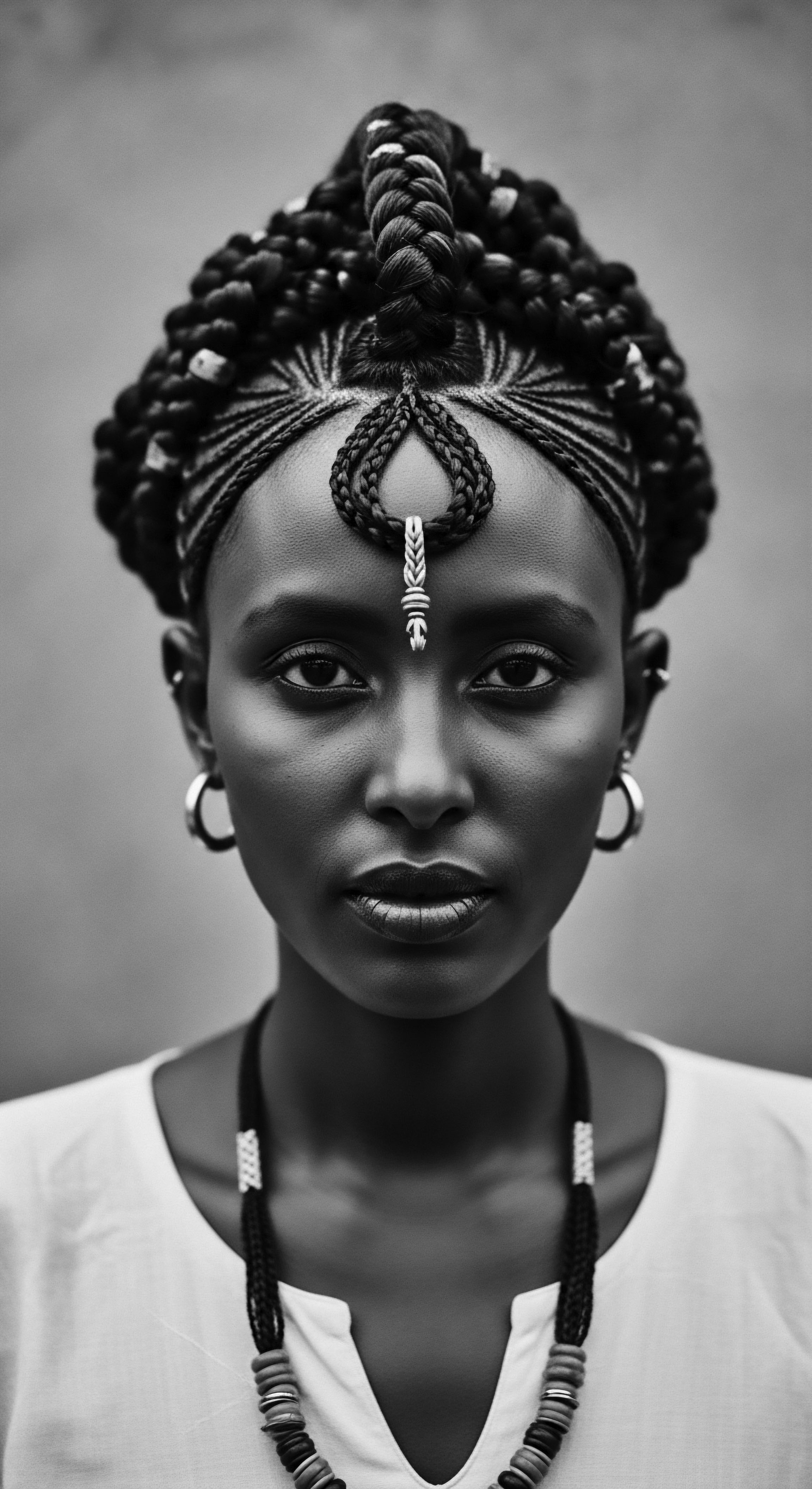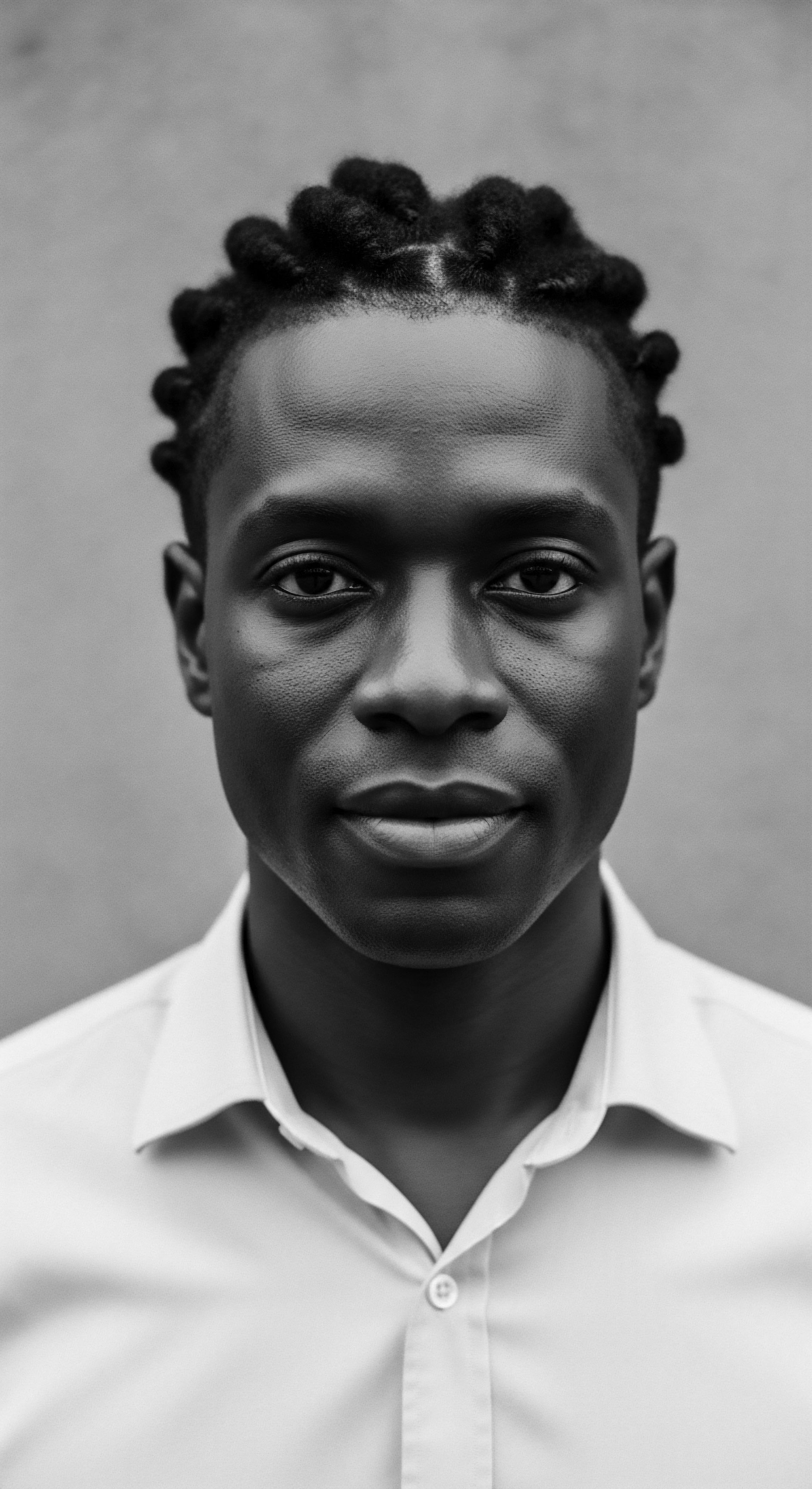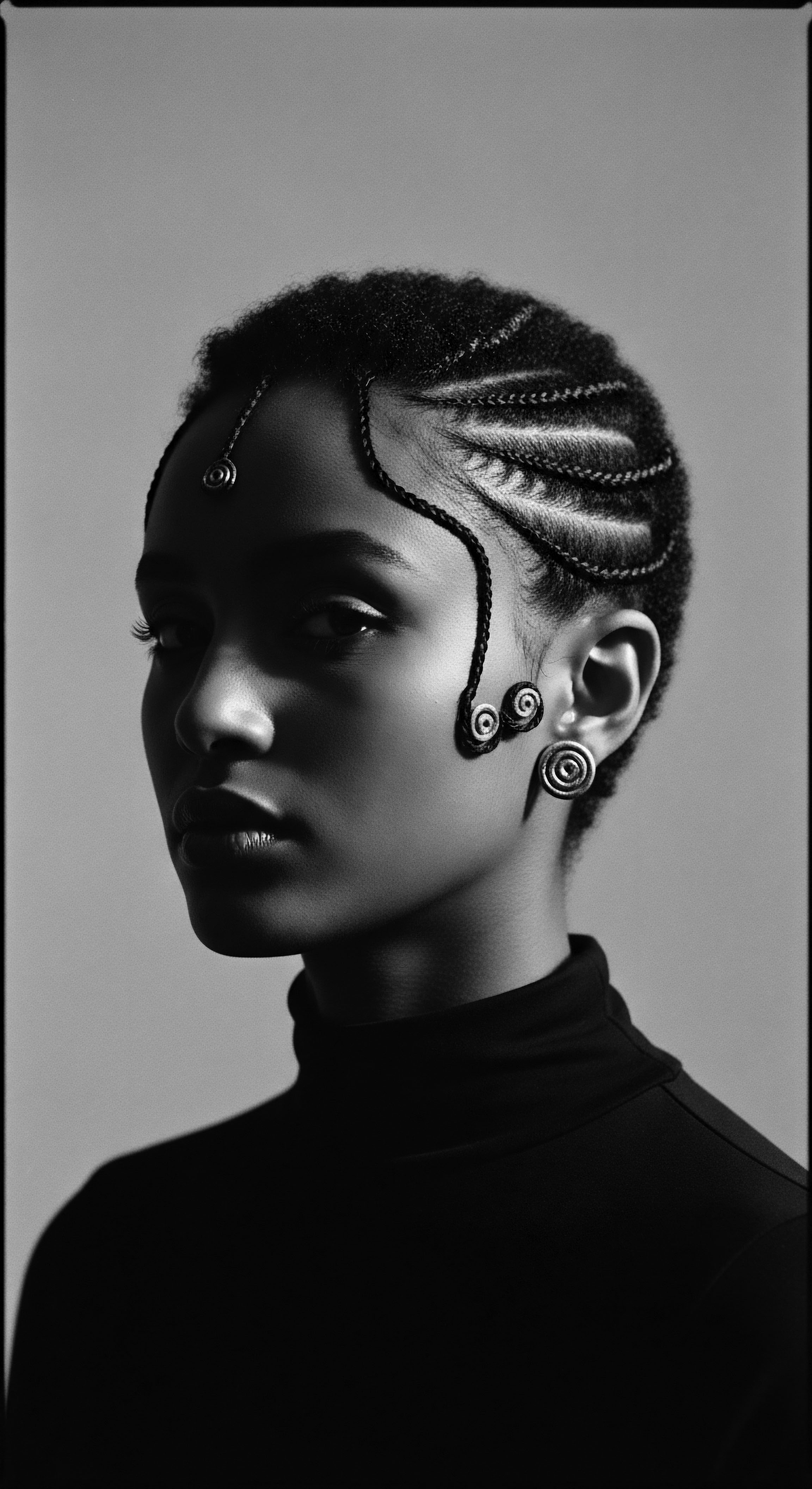
Roots
For those of us who tend to textured hair, whether coils, curls, or waves, the strands on our heads represent far more than simply adornment. Each curl holds ancestral memory, a connection to generations who understood hair not just as a physical attribute but as a vibrant extension of spirit, identity, and cultural lineage. Our journey with our hair is deeply personal, often shaped by stories passed down through families, by shared wash days, and by the collective experience of navigating beauty standards. This living legacy compels us to consider how we nurture our crowns, prompting a profound question ❉ can Ghassoul, this ancient clay, truly replace the sophisticated modern hair products that fill our shelves, perhaps offering a path back to a care philosophy rooted in heritage?

A Geological Gift and Heritage
From the sun-drenched valleys of the Atlas Mountains in Morocco, Ghassoul clay has emerged for centuries as a cornerstone of ancestral beauty rituals. Its name, derived from the Arabic “rassala,” meaning “to wash,” directly reflects its cleansing properties, a role it has served for millennia. This unique mineral clay, specifically a type of stevensite, was formed from volcanic deposits, its very composition a testament to the earth’s deep history. For generations, Berber communities have cherished this rare mineral for its purifying and softening abilities, using it as a natural soap and shampoo, not only for hair but for the body too.
Ghassoul clay is a mineral-rich volcanic clay, a geological gift from Morocco’s Atlas Mountains, deeply intertwined with ancestral cleansing traditions.
The historical significance of Ghassoul stretches back beyond recorded modern history. Ancient Egyptian papyri reportedly mention its regenerative and healing properties, a testament to its long-held recognition across North Africa and the Near East. Even the Greeks and Romans recognized its cleansing power, using it to maintain their skin and hair’s luster.
This clay holds such a respected place in Moroccan culture that it remains a traditional offering in a bride’s dowry, alongside other cherished elements like Argan oil and black soap. Such practices underscore a profound reverence for natural ingredients and their role in personal and communal well-being, demonstrating how historical usage validates its enduring value.

Textured Hair’s Unique Architecture
To truly understand Ghassoul’s potential, one must first grasp the distinctive architecture of textured hair. Unlike straighter hair types, coiled and curly strands possess a more intricate structure. The elliptical shape of the hair follicle creates a helical growth pattern, leading to curls and coils. This shape means the cuticle, the hair’s protective outer layer, is often more raised and open, allowing moisture to escape more readily.
This characteristic is precisely why textured hair often thirsts for hydration and can be prone to dryness and tangles. The very science of hair, in its biological foundations, provides insights into why ancestral practices focused so heavily on conditioning and gentle cleansing.
The challenges of dryness and breakage have shaped traditional hair care approaches within Black and mixed-race communities for centuries. Ancestral practices often centered on moisturizing ingredients, protective styling, and gentle handling to preserve length and health. This understanding of hair biology, whether articulated through scientific terms or through generations of observation, has always guided the hands that cared for textured hair.

How Does Ghassoul Clay Interact with Hair at a Micro Level?
The molecular structure of Ghassoul clay presents a compelling natural alternative. It comprises a unique blend of minerals such as Silica, Magnesium, Calcium, and Potassium, with some sources indicating up to nearly 60% silicon and 25% magnesium content. These minerals contribute to its cleansing and nourishing properties. The clay possesses a negative charge, which is believed to draw out positively charged impurities, toxins, and excess oils from the scalp and hair.
Unlike harsh sulfates common in many modern shampoos, which strip hair of natural oils, Ghassoul cleanses gently. Its absorbent properties allow it to bind to sebum and product buildup, which are then rinsed away, leaving hair clean but not parched. This selective cleansing action makes it particularly suited for textured hair, which benefits from preserving its inherent moisture. The fine, silky texture of the clay also contributes to its gentle nature, allowing it to purify the scalp and strands without causing irritation.

The Language of Textured Hair Care
The lexicon surrounding textured hair has evolved, reflecting both its scientific understanding and cultural significance. Traditional terms often spoke to the lived experience of hair, its appearance, and the rituals surrounding its care. Today, we have more specific classifications, but a respect for historical language grounds our present discourse.
- Coil ❉ A tight, spring-like curl pattern, often with a small diameter.
- Kink ❉ A very tight curl with sharp angles, prone to shrinkage.
- Porosity ❉ The hair’s ability to absorb and retain moisture, a crucial factor for textured hair care.
- Sealing ❉ The practice of locking in moisture with oils or butters after hydrating the hair.
- Detangling ❉ The careful process of separating intertwined strands, often done with a wide-tooth comb or fingers.
The very terms we use to describe textured hair and its care carry echoes of resilience and ingenuity. The need for specialized products arose from both the unique structural demands of these hair types and, historically, a lack of mainstream understanding or provision for them. This context is important when considering whether an ancient ingredient like Ghassoul can step into a modern role.

Ritual
The hands that shaped ancestral hair were guided by purpose, often performing acts of care steeped in community, tradition, and artistry. Styling textured hair has never been a mere aesthetic pursuit; it has consistently been a profound cultural statement, a marker of identity, status, and survival. From the intricate patterns of ancient braids to the elaborate adornments, each style tells a story, a narrative passed through generations. Within this vibrant tapestry of hair practices, where does Ghassoul clay find its place, and how does its use align with these deeply embedded rituals?

Hair as Historical Record
In many African cultures, hair served as a sophisticated visual language. Braids, for instance, date back as far as 3500 BCE, their patterns conveying social status, marital status, wealth, kinship, and religious beliefs within tribes in regions like Ethiopia, Sudan, and Eritrea. This tradition extended into the African diaspora, where, during the brutal era of enslavement in America, hair became a silent, powerful tool of resistance.
Enslaved women would braid intricate patterns that sometimes acted as escape maps or hid seeds for cultivation in new lands, a poignant example of hair as a means of communication and survival (Allen, 2021). The deep care involved in such practices, often done in communal settings, reinforced bonds and preserved cultural identity under immense pressure.
Hair, in its varied forms and styles, has always been a powerful expression of identity, resilience, and connection to cultural heritage across generations.
The return to natural hair, movements that gained strength in the 1960s with the “Black is Beautiful” movement, and again in the 2000s, reflect a conscious reclamation of this heritage. These movements championed textured hair in its authentic forms, moving away from Eurocentric beauty standards that had historically pushed for chemical straightening and alteration. The tools and techniques employed today, whether for protective styles or for defining natural patterns, carry the echoes of these historical journeys. The question now becomes ❉ can an ancestral ingredient like Ghassoul support these contemporary expressions of heritage?

Traditional Care Meets Modern Application
For centuries, the use of Ghassoul was integral to hammam rituals, public baths where cleansing and rejuvenation were communal and holistic experiences. Moroccan women mixed the clay with rose water, herbs, or essential oils, applying it to hair and skin as a purifying mask. This ritual was not a fleeting act but a time-honored practice, passed from mother to daughter, preserving a secret preparation process involving maceration of gross clay stones with various botanicals. Such careful preparation speaks to a deep, considered approach to beauty, where ingredients were understood and manipulated to enhance their natural properties.
Modern hair products, on the other hand, often prioritize convenience and immediate gratification. Shampoos lather copiously, conditioners detangle swiftly, and styling products offer instant hold. These products are often highly processed, containing synthetic ingredients designed for specific, often isolated, effects. Yet, for textured hair, some synthetic components can be counterproductive, leading to buildup, dryness, or a lack of natural movement.
Can Ghassoul, with its traditional preparation and application, fit into our busy modern lives while delivering comparable benefits? The answer, perhaps, lies in adapting the ancestral wisdom to contemporary rhythms. While preparing Ghassoul from raw stones might be time-consuming, powdered forms are readily available, requiring only water for activation. This simplification allows for integrating a piece of ancestral care into a busy schedule.
| Aspect Cleansing |
| Traditional Use of Ghassoul Gentle washing without stripping oils; leaves hair soft and manageable. |
| Modern Product Equivalency Sulfate-free shampoos, co-washes. |
| Aspect Conditioning |
| Traditional Use of Ghassoul Mineral-rich hydration; strengthens hair strands, improves elasticity. |
| Modern Product Equivalency Deep conditioners, leave-in treatments. |
| Aspect Detangling |
| Traditional Use of Ghassoul Slippery consistency aids in smoothing strands. |
| Modern Product Equivalency Detangling sprays, conditioner formulations. |
| Aspect Scalp Care |
| Traditional Use of Ghassoul Absorbs excess oil, impurities; soothes irritation, helps with dandruff. |
| Modern Product Equivalency Scalp scrubs, clarifying treatments. |
| Aspect Ghassoul’s ancient utility often mirrors the specialized functions of multiple modern hair care products, presenting a unified approach to hair and scalp well-being. |

A Toolkit Rooted in Simplicity and Efficacy
The traditional toolkit for textured hair was one of simplicity, often relying on fingers, wide-tooth combs carved from wood, and natural fibers for styling. These tools were chosen for their gentleness, minimizing breakage, and working harmoniously with the hair’s natural curl pattern. The historical emphasis was on working with the hair, not against it.
In this context, Ghassoul complements the approach beautifully. It provides a natural slip, making detangling a less arduous process, honoring the delicate nature of coiled strands.
Consider the contrast with modern hair tools, many of which involve heat—flat irons, curling wands, blow dryers. While these offer versatility, their misuse can compromise hair health, leading to dryness and breakage, particularly for textured hair, which is already prone to moisture loss. The traditional wisdom of minimizing heat aligns with Ghassoul’s gentle, no-heat cleansing and conditioning properties.
Utilizing Ghassoul as a primary cleanser means reducing the need for harsh chemicals that might necessitate more intensive conditioning or heat styling to compensate for stripping. This shift in practice supports a more holistic approach, prioritizing the hair’s inherent health over temporary stylistic alterations.

Relay
The narrative of textured hair care stretches across continents and centuries, a living relay race where ancestral wisdom passes the baton of knowledge to contemporary hands. It is a story of adaptation, resilience, and the enduring quest for hair health and self-expression. In this continuum, the role of natural remedies, such as Ghassoul clay, becomes particularly compelling, inviting us to consider whether these time-honored practices can truly provide comprehensive care in a world dominated by scientific formulations and mass-produced products.

Ancestral Wisdom and Modern Science Intersect
The efficacy of Ghassoul, long celebrated in North African communities, is increasingly supported by modern scientific understanding. The clay’s mineral composition—rich in Magnesium, Silica, Calcium, and Potassium—lends it unique properties. These minerals are known to contribute to hair strength and elasticity. Magnesium, for instance, can soothe irritated scalps and may support hair growth, while silica strengthens hair shafts.
The clay acts as a natural absorbent, drawing out impurities and excess sebum without stripping the hair’s essential oils, a gentler approach compared to many conventional shampoos containing harsh surfactants. This deep, yet gentle, cleansing action aligns perfectly with the needs of textured hair, which benefits from minimal stripping to retain its precious moisture.
Scientific characterization of Ghassoul has confirmed its composition, detailing its mineralogical properties and adsorption capacities . Research indicates that Ghassoul is primarily composed of stevensite, a magnesium-rich clay, and possesses excellent adsorption properties, making it effective at binding to impurities and toxins. This scientific validation of a centuries-old practice speaks volumes, bridging the gap between traditional knowledge and contemporary understanding. It highlights how practices passed down through generations often hold scientific truths that modern research is only now beginning to quantify and explain.
The scientific backing for Ghassoul’s mineral composition and purifying attributes solidifies its place as a viable alternative for textured hair, confirming ancestral insights.
Consider the broader context of natural hair care. The movement towards embracing natural textures, particularly among Black and mixed-race communities, represents a powerful re-alignment with ancestral practices. This includes a growing interest in ingredients that are minimally processed, sourced from the earth, and have a history of beneficial use.
The emphasis is on nourishing the hair and scalp without relying on synthetic compounds that can lead to unforeseen issues down the line. The Chad Basin’s Chebe powder, another ancient hair paste, offers a parallel example, demonstrating how regional natural ingredients have historically supported hair length retention and health, passed down from mothers to daughters.

Building Personalized Regimens with Ancestral Echoes
Creating a hair care regimen for textured hair is inherently personal, a dance between understanding one’s unique strands and drawing from a wealth of shared knowledge. Ancestral wisdom often encouraged a holistic view of well-being, where hair health was connected to diet, internal balance, and mindful self-care. Integrating Ghassoul into a regimen invites a return to this holistic perspective. It necessitates a more hands-on approach, mixing the clay with water, perhaps adding herbs or oils, making the hair care routine a deliberate, meditative ritual rather than a hurried task.
For individuals seeking to replace modern hair products, Ghassoul offers a distinct shift. It replaces not just one product, but potentially several ❉ shampoo, conditioner, and even some scalp treatments. The method of application, typically a paste applied to wet hair and scalp, allows for direct contact with the minerals, promoting scalp health and cleansing without harsh foaming agents. Following a Ghassoul wash, many find their hair softer and more manageable, sometimes negating the need for a separate conditioner, especially when oils like argan oil or rose water are incorporated into the mixture, as is traditionally done.
Problem-solving for textured hair, such as addressing dryness, breakage, or scalp irritation, can also draw upon Ghassoul’s properties. Its ability to absorb excess sebum and calm the scalp makes it a valuable ally for those experiencing flakiness or oiliness. For dryness, the conditioning minerals can offer relief, especially when the clay is used in moderation and followed by nourishing oils. The historical wisdom dictates that care is constant, and patience is a virtue, lessons applicable to any hair care journey, especially one moving towards more natural solutions.

Nighttime Sanctuary ❉ Bonnet Wisdom and Protective Measures
The nighttime ritual for textured hair is a cornerstone of maintenance, a practice of protection and preservation. From the careful wrapping of hair in silk scarves to the use of bonnets, these habits are rooted in the necessity of preserving moisture and preventing friction-induced breakage overnight. This wisdom extends back generations, with women in the diaspora understanding the need to safeguard their hair while they slept.
The use of bonnets and wraps, often simple cotton or silk fabrics, represents a practical yet powerful protective measure, ensuring that the moisture imparted during daily rituals is not lost to pillows and bedding. This dedication to protective measures highlights a deep understanding of hair’s vulnerability and a commitment to its longevity.
When using Ghassoul, this nighttime care remains essential. The clay, while gentle, cleanses thoroughly. Protecting the hair post-wash with a bonnet or silk scarf ensures that the clean, conditioned strands are not immediately exposed to elements that could reverse the benefits. This continuity of care, from cleansing to protection, reflects a holistic approach where each step supports the overall health and integrity of textured hair, echoing ancestral practices of sustained attention to hair wellbeing.
Beyond Ghassoul, many traditional ingredients continue to hold sway. The Basara tribe in Chad, for instance, uses Chebe Powder mixed with animal fat to reduce breakage and support length, a testament to localized ancestral wisdom. In South Asia, Hair Oiling with herbal oils like amla or coconut oil, a practice originating thousands of years ago in Ayurvedic tradition, remains a vital ritual for scalp health and hair strength.
These examples illustrate that while modern products offer convenience, the collective ancestral wisdom points to natural, time-intensive methods that prioritize hair’s innate health over quick fixes. Whether Ghassoul can truly replace modern hair products depends on an individual’s willingness to re-engage with a more intentional, heritage-informed approach to hair care.
- Mineral Absorption ❉ Ghassoul clay excels at absorbing impurities, excess oil, and toxins from the scalp without harsh stripping.
- Detangling Aid ❉ When mixed with water, it creates a slippery paste that assists in detangling textured strands, reducing breakage during the wash process.
- Hair Strength ❉ Its rich mineral profile, particularly silica and magnesium, contributes to strengthening hair shafts and improving elasticity.

Reflection
To stand at this juncture of ancient wisdom and modern innovation, pondering if Ghassoul can truly replace the array of contemporary hair products for textured hair, is to engage in a profound dialogue with our past. It is not merely a question of efficacy; it is a meditation on the Soul of a Strand, on the inherent heritage coiled within every helix and curve of our hair. The journey of textured hair care, from the communal rituals of ancient Africa to the individualized regimens of today, speaks to a continuous thread of resilience, creativity, and self-definition.
Ghassoul clay, born from the earth’s deep geological memory, offers a compelling echo of ancestral practices. It invites us to slow down, to engage with our hair in a more mindful way, to feel the minerals on our fingertips as they cleanse and nourish, much as generations before us did. This return to elemental care is not a rejection of progress but a re-evaluation of what truly serves our hair and our spirit. It reminds us that often, the answers we seek in complex formulations might reside in the simple, yet potent, gifts of the earth that our ancestors knew so intimately.
The legacy of textured hair care is one of adaptation and enduring beauty. Whether through the elaborate braiding patterns that conveyed status and community, or the quiet, persistent acts of nourishing strands to defy imposed standards, our hair has always carried stories. Ghassoul stands as a testament to this legacy, a tangible link to a time when beauty practices were deeply intertwined with cultural identity and natural resources.
Its continued relevance in a world of advanced cosmetology suggests a deeper longing for authenticity, for practices that honor not just our appearance but our lineage, our very being. The future of textured hair care, in many ways, looks to its past, seeking balance, respect, and a profound connection to the wisdom that has always guided our strands.

References
- Bettiche O, Melhaoui A, Malek F. (2012). Mineralogical and Physico-Chemical Characterization of the Rhassoul Clay of Morocco. Clay Minerals.
- Souhail B, Idrissi L, Mouhib M, et al. (2013). Physicochemical and Mineralogical Characterization of a Natural Moroccan Clay ❉ Rhassoul. Journal of Materials and Environmental Science.
- Tokarský, J. (2018). Ghassoul – Moroccan clay with excellent adsorption properties. Materials Today ❉ Proceedings, 5(1), S78-S87.
